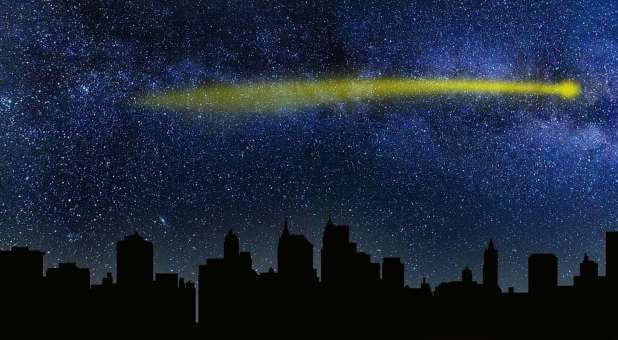Christian churches that follow a liturgical calendar will observe Epiphany Sunday on Jan. 7, a time to celebrate Jesus as the light that shines in the darkness, as spoken of in John 1:1-5.
The word “epiphany” comes from the Greek epiphaneia and means “manifestation.” This church ritual recognizes the post-nativity arrival of the Gentile kings or magi of Matthew’s Gospel account (1:1-12) and the “manifestation” of the star that they followed to worship the one born as the “light of the world.”
Epiphany Sunday is observed on the closest Sunday to the 12th day after Christmas (Jan. 6).
God in Human Flesh
This calendared event is a reminder of the incarnation of Jesus Christ, as taught in the first chapter of John’s Gospel:
“Before anything else existed, there was Christ, with God. He has always been alive and is Himself God. He created everything there is—nothing exists that He didn’t make. Eternal life is in him, and this life gives light to all mankind. His life is the light that shines through the darkness—and the darkness can never extinguish it. … And Christ [literally the Word] became a human being and lived here on earth among us and was full of loving forgiveness and truth. And some of us have seen His glory—the glory of the only Son of the heavenly Father!” (John 1:1-5, 14, TLB).
This God, incarnate in human flesh, “was accredited by God to you by miracles, wonders and signs“ (Acts 2:22b, NIV) and also fulfilled many prophecies during Jesus’ relatively short ministry. As the God-Man, He suffered and died to pay the price of redemption from our bondage to sin and its consequences.
His sacrificial death took the penalty we deserve and ransomed us from the grip of sin and its eternal separation from our heavenly Father. This Good News of eternal life is possible exclusively through Jesus Christ, who said, “I am the way, and the truth, and the life. No one comes to the Father except through Me” (John 14:6, ESV).
Our Triune God
When Jesus was asked about the most important commandment, He replied, “Hear, O Israel, the Lord our God, the Lord is one” (Mark 12:29). This is called the Shema Yisrael and is the centerpiece of the Jewish morning and evening prayer services. It expresses the monotheistic essence of Judaism (Deut. 6:4 and Ps. 86:10).
Yet the New Testament introduces us to Jesus and the Holy Spirit when it teaches our God is trinitarian in function and singular in essence. The Father, Son and Holy Spirit are each unique in function and yet equal in value. The Father is not the Son nor the Spirit and the Son is not the Father nor the Spirit. The same uniqueness is true for the Spirit.
For instance, in John 16:13-15 (NIV), Jesus shows that the three persons of the godhead are closely related. He explains, “When He, the Spirit of truth, comes, He will guide you into all the truth. He will not speak on His own; He will speak only what He hears, and He will tell you what is yet to come. He will glorify Me because it is from Me that He will receive what He will make known to you. All that belongs to the Father is Mine. That is why I said the Spirit will take from what is Mine and make it known to you.”
Some have found a simple illustration from science to be helpful in understanding this trinitarian conundrum. Water can be found in three states: a liquid, a solid (ice) or a gas (steam). All three states maintain the same essence of H20. These three persons of the Trinity are united as one, in essence.
The Trinity can be seen together at the same time in various biblical passages. Think of Jesus’ baptism in the Jordan River by His relative, John the Baptist. This major event is recorded in three of the four gospels (Matthew, Mark and Luke). People were coming to the evangelist to repent of their sins and to be ritually cleansed or purified by the symbolic washing of water (Matt. 3:13-17). Though Jesus was sinless, He insisted on being baptized as an example to His followers and to be spiritually ordained for His ministry as the divine-human Messiah. The Living Bible reads:
“Then Jesus went from Galilee to the Jordan River to be baptized there by John. John didn’t want to do it. ‘This isn’t proper,’ he said. ‘I am the one who needs to be baptized by you.’ But Jesus said, ‘Please do it, for I must do all that is right.’ So then John baptized Him. After His baptism, as soon as Jesus came up out of the water, the heavens were opened to Him and He saw the Spirit of God coming down in the form of a dove. And a voice from heaven said, ‘This is My beloved Son, and I am wonderfully pleased with Him.'”
All three persons of the Trinity are clearly seen here. Jesus had just emerged from the water when He saw the Holy Spirit “descending like a dove and alighting on him” (v. 16, NIV). Then the voice of Father God spoke from heaven, commending the Son. In John 1:33-34, John the Baptist testified that God had alerted him that “The man on whom you see the Spirit come down and remain is He who will baptize with the Holy Spirit. I have seen and I testify that this is God’s Chosen One.”
The Trinity and the Church
After Jesus’ resurrection, He appeared to many disciples during a period of 40 days, with “convincing proofs” that He was, in fact, alive! He instructed them about the kingdom of God and prepared them for His departure and the prophesied coming of the Holy Spirit (Acts 1:3-5).
Sign up NOW for a FREE Charisma Magazine Online 30-day trial!
The startling events surrounding the prophesied outpouring of the Holy Spirit on the Day of Pentecost were 50 days after Jesus’ resurrection and following His ascension to heaven (Acts 1:9-11). Peter referenced the members of the Trinity in his sermon to the crowd of Jews in the temple court on that important day:
“This Jesus God raised up, and of that we all are witnesses. Being therefore exalted at the right hand of God, and having received from the Father the promise of the Holy Spirit, He has poured out this that you yourselves are seeing and hearing” (Acts 2:32-33, ESV).
Additionally, the three personalities of the Trinity (the Father, Son and Holy Spirit) were associated together in other passages of the New Testament. Most famously, they are individually mentioned in the Great Commission: “Go therefore and make disciples of all nations, baptizing them in the name of the Father and of the Son and of the Holy Spirit” (Matt. 28:19).
Some question an apparent contradiction in Acts 2:38, where Peter instructs spiritual inquirers to “Repent and be baptized every one of you in the name of Jesus Christ for the forgiveness of your sins, and you will receive the gift of the Holy Spirit.” This differs from the fuller baptismal formula given above, in Matthew 28:19.
Peter’s abbreviated instruction, “baptized … in the name of Jesus Christ,” on Pentecost is focused on the “forgiveness of your sins,” which was made possible by Jesus’ death, burial and resurrection. It was not the baptismal formula that brought about forgiveness; rather, forgiveness comes through that which is only symbolized by baptism, where we are buried with Him into death and raised up to live a new, victorious life with Him. We are to be “dead to sin and alive to God in Christ Jesus” (Rom. 6:11b).
Finally, the members of our triune God are also found in Paul’s apostolic benediction: “The grace of the Lord Jesus Christ and the love of God and the fellowship of the Holy Spirit be with you all” (2 Cor. 13:14). So, as we have seen, the New Testament established the basis for the doctrine of the Trinity.
Walking in the Light
May the reflective moments of this Epiphany Sunday remind us of the importance of celebrating and serving Jesus, “the light of the world” (John 8:12-30), while living in the midst of the heavy spiritual and cultural darkness around us:
“But if we walk in the light, as he is in the light, we have fellowship with one another, and the blood of Jesus his Son cleanses us from all sin,” (1 John 1:7).
Join Charisma Magazine Online to follow everything the Holy Spirit is doing around the world!
Gary Curtis served for 27 years as part of the pastoral staff of The Church on The Way, the First Foursquare Church of Van Nuys, California. Since retirement in 2016, he continues to blog at worshipontheway.wordpress.com. Gary and his wife live in southern California and have two married daughters and five grandchildren.






Leave a Comment
You must be logged in to post a comment.